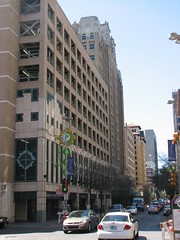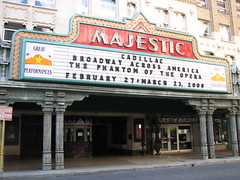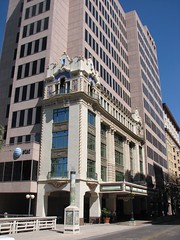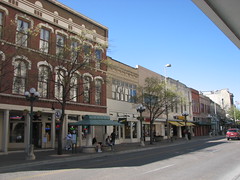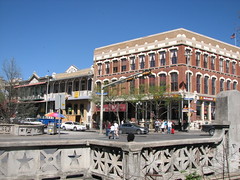Cities: March 2008 Archives
My one-day, work-related trip yesterday was kind of a bust, but it did leave me with some time to explore San Antonio before my flight home. I drove into downtown and took a set of photos illustrating what's right about downtown San Antonio's urban design. As I was walking down Houston St. and snapping pictures of buildings, a fellow called out and told me I should take a picture of him and his friend. So I did.
(Clicking on any photo below will take you to the Flickr photo page, where you can see larger images.)
That's Mike on the left and Jesse on the right. (Mike is the one that hollered at me.) They work for a company that does convention and event decorating, and they were fitting out a vacant retail space for use as a gallery during an upcoming downtown arts festival. I told them I'd post the photo on my blog, and Mike wrote down the URL. Mike told me that some of these older buildings (the sort that Tulsa real estate types would call "functionally obsolete" and therefore wrecking ball bait) were being converted to hotels, to meet the growing convention demand. San Antonio, he said, is great for conventions year-round, since it never gets that cold. (It was sunny and 91 yesterday.)
The striking thing about downtown San Antonio is that there are so few surface parking lots. This is one of the few, and the sidewalk is screened with palm trees to mitigate the visual impact.
Parking garages have street-level retail. (In the picture below, that's a parking garage on the left in the foreground.)
You have a continuous street wall on both sides of the street that obeys the Three Rules -- David Sucher's guidelines for creating walkable urban places.
Instead of tearing down their grand old theaters, they saved one, the Majestic, as a performing arts center:
They saved the facade and the box office kiosk of the Texas Theater and built a new building behind it. Not the ideal form of preservation, but better than nothing.
I took a number of photos to illustrate that compatibility doesn't mean uniformity, a salient point in the debate over neighborhood conservation districts. (In some cities, conservation districts protect commercial areas. The ordinance being discussed for Tulsa only covers residential areas.) This photo of Alamo Plaza shows buildings from a number of different eras and in a number of different styles -- late Victorian, Plains commercial, Art Deco, Mid-Century -- but similar in scale and setback and all with street-level windows for retail spaces.
And as Tulsa's wise men know, major retailers will never come to a city where they can't build their standard store designs. They will shun areas with conservation district overlays. Right?
That's a McDonald's on the right, next to a Subway, next to a Fuddruckers.
There is plenty right with downtown San Antonio. I suspect the history-proud Texans of that city have some rules in place to keep it that way. I'll let you know what I find out.
MORE: These are the zoning districts (base zoning and overlay) that apply to various parcels in the River Walk and Alamo area:
D Downtown District (Sec. 35-310.11)
This zone provides concentrated downtown retail, service, office and mixed uses in the existing central business district. Examples of permitted uses include: Indoor Theatres, Taxi Service, Apartments (6 dwelling units through 50 dwelling units per gross acre), Hotels, Motels, Offices (no restrictions on square footage
unless otherwise prescribed), and Telephone Equipment Infrastructure.
H Historic Districts and Landmarks (Sec. 35-333)
These are areas in which the cultural or archaeological identity, architectural features, or overall character are considered historically significant. Historic Districts often contain one or more buildings, objects, sites, or structures designated as significant or exceptional historic landmarks.
HS Historic Significance Districts (Sec. 35-333)
Historic Significant Landmarks are those considered to be important and their demolition would mean a serious loss to the character of the city.
HE Historic Exceptional Districts (Sec. 35-333)
Historic Exceptional Landmarks are those considered most unique in terms of historic, cultural, archeological significance. Demolition would mean an irreplaceable loss to the quality and character of the city.
RIO 1-6 River Improvement Overlay District (Sec. 35-338)
Overlay district that imposes regulations to protect, preserve and enhance the San Antonio River and its improvements by establishing design standards and guidelines for properties located near the river.
VP Viewshed Protection Districts
Overlay district that imposes regulations to protect, preserve and enhance the views and vistas of historic places, landmark buildings, and other sites of cultural importance.
Here's a link to the San Antonio Unified Development Code and the starting page for launching the city's GIS map viewer for zoning.


